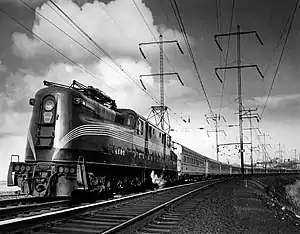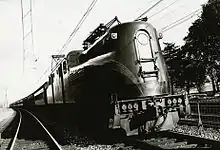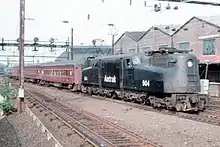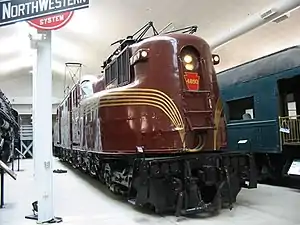Pennsylvania Railroad class GG1
The Pennsylvania Railroad GG1 was a class of electric locomotives built for the Pennsylvania Railroad (PRR), in the northeastern United States. Between 1934 and 1943 General Electric and the PRR's Altoona Works built 139 GG1s.
| PRR Class GG1 | |||||||||||||||||||||||||||||||||||||||||||
|---|---|---|---|---|---|---|---|---|---|---|---|---|---|---|---|---|---|---|---|---|---|---|---|---|---|---|---|---|---|---|---|---|---|---|---|---|---|---|---|---|---|---|---|
 4868 hauling The Congressional | |||||||||||||||||||||||||||||||||||||||||||
| |||||||||||||||||||||||||||||||||||||||||||
| |||||||||||||||||||||||||||||||||||||||||||
| |||||||||||||||||||||||||||||||||||||||||||
| |||||||||||||||||||||||||||||||||||||||||||
The GG1 entered service with the PRR in 1935 and later ran on successor railroads Penn Central, Conrail and Amtrak. The last GG1 was retired by New Jersey Transit in 1983. Most have been scrapped, but sixteen are in museums.[1]
Technical information
Body and mechanical
The GG1 was 79 feet 6 inches (24.23 m) long and weighed 475,000 pounds (215,000 kg).[2] The frame of the locomotive was in two halves joined with a ball and socket joint, allowing the locomotive to negotiate sharper curves.[3] The body rested on the frame and was clad in welded steel plates. The control cabs were near the center of the locomotive on each side of the main oil-cooled transformer and oil-fired train-heating boiler. This arrangement, first used on the PRR's Modified P5 class, provided for greater crew safety in a collision and provided for bi-directional operation of the locomotive.[4] Using Whyte notation for steam locomotives, each frame is a 4-6-0 locomotive, which in the Pennsylvania Railroad classification system is a "G". The GG1 has two such frames back to back, 4-6-0+0-6-4. The related AAR wheel arrangement classification is 2-C+C-2. This means one frame mounted upon a set of two axles unpowered (the "2") and three axles powered (the "C") hinged with the ball and socket to another frame of the same design (the +). The unpowered "2" axles are at either end of the locomotive. The GG1 was equipped with Leslie A200 horn.
Electrical and propulsion
A pantograph on each end of the locomotive body was used to collect the 11,000 V, 25 Hz alternating current (AC) from the overhead lines. In operation the leading pantograph was usually kept lowered and the trailing raised to collect current, since if the rear pantograph failed it would not strike the forward pantograph. A transformer between the two cabs stepped down the 11,000 V to the voltages needed for the traction motors and other equipment.[4] Twelve 385-horsepower (287 kW) GEA-627-A1 traction motors (AC commutator motors, not AC induction motors[5]) drove the GG1's 57-inch (1,448 mm) diameter driving wheels on six axles using a quill drive. The power required was such that double traction motors were used, with two motors driving each axle. The traction motors were six-pole field, 400 volts, 25 Hz rated each at 385 hp (287 kW). The motors were frame-mounted using quill drives to the sprung driving wheels providing a flexible suspension system across a relatively long locomotive frame which allowed full wheel weight to rest on the rail for good traction regardless of track condition. A series wound commutator motor's speed is increased by increasing the applied voltage to the motor thus increasing the current through the motor's armature which is necessary for increasing its torque, thus increasing motor speed.[6][7] The engineer's cab had a 21 position controller for applying voltage to the motors. Four unpowered leading/trailing wheels were mounted on each end of the locomotive.
Steam generation for heating
At the time of the GG1's introduction, railroad passenger cars required steam from the locomotive to operate heating equipment. The GG1 had an oil-fired steam generator to provide this steam to the train's "steam line."[8]
History
Beginning in the early 1910s, the PPR received the FF1 but decided it was too slow for passenger trains and was relegated to heavy freight service. In the mid 1920s, they received the L5 electric which had third rail power supply at the time. When the Pennsylvania built the O1 and the P5, they chose the P5 over the O1 for its ability and power on the rails. After a grade crossing accident with the P5, the cab was moved to the center and was designated P5a. Pennsylvania still searched for the ultimate electric since the P5 did not track well at high speeds and were wondering if the P5a could be improved even further. Soon enough, the Pennsylvania was in luck and found two contacts as early as 1932. The mechanical design of the GG1 was based largely on the New Haven EP3, which had been borrowed earlier from the New York, New Haven & Hartford Railroad by the PRR to compare it to its current standard electric locomotive, the P5a.[9] In 1933, the PRR decided to replace its P5a locomotives and told General Electric and Westinghouse to design prototype locomotives with the following specifications: a lighter axle load and more power than the P5a, a top speed of at least 100 miles per hour (160 km/h), a streamlined body design and a single (central) control cab.[10]

Both companies delivered their prototypes to PRR in August 1934.[11] General Electric submitted the GG1 and Westinghouse submitted the R1. The R1 was essentially "little more than an elongated and more powerful version of the P5a" with an AAR wheel arrangement of 2-D-2.[11] Both locomotives were tested for ten weeks in regular service between New York and Philadelphia and on a test track in Claymont.[12] Because the R1's rigid wheelbase prevented it from negotiating sharp curves and some railroad switches, PRR chose the GG1 and ordered 57 additional locomotives on November 10, 1934.[12] Of the 57, 14 were to be built by General Electric in Erie and 18 at the Altoona Works. The remaining 20 locomotives were to be assembled in Altoona with electrical components from Westinghouse in East Pittsburgh and chassis from the Baldwin Locomotive Works in Eddystone.[13] An additional 81 locomotives were then built at Altoona between 1937 and 1943.[14]
On January 28, 1935, to mark the completion of the electric line from Washington, D.C. to New York City, PRR ran a special train hauled by Pennsylvania Railroad 4800 before it opened the line for revenue service on February 10.[15] It made a round trip from D.C. to Philadelphia and, on its return trip, set a speed record by arriving back in D.C. 1 hour and 50 minutes after its departure from Philadelphia.[15]
In 1945, a Pennsylvania GG1 hauled the funeral train of President Franklin D. Roosevelt from Washington Union Station to New York Pennsylvania Station.[16]
In the mid-1950s, with declining demand for passenger train service, GG1s 4801–4857 were re-geared for a maximum speed of 90 miles per hour (140 km/h) and placed in freight service.[17] They initially retained their train heating steam generator, and were recalled to passenger service for holiday season mail trains,[17] and 'Passenger Extras' such as those run for the annual Army–Navy football game in Philadelphia.[18]
.jpg.webp)
.jpg.webp)
Timetable speed limit for the GG1 was 75-80 mph until October 1967 when some were allowed 100 mph for a couple of years; when Metroliner cars were being overhauled in the late 1970s, GG1s were again allowed 100 mph for a short time when hauling Amfleet cars on trains scheduled to run 224.6 miles from New York to Washington in 3 hours, 20–25 minutes.
On June 8, 1968, two Penn Central GG1s hauled Robert F. Kennedy's funeral train.[19]
Shell design
The first designer for the GG1 project was industrial designer Donald Roscoe Dohner, who produced initial scale styling models, although the completed prototype looked somewhat different.[20][21] At some point, PRR hired famed industrial designer Raymond Loewy to "enhance the GG1's aesthetics."[12][20] The final design is retrospectively 'Art Deco' as we know it today.
Although it was thought until 2009 that Loewy was solely responsible for the GG1's styling, Dohner is now understood to have contributed as well. (Dohner's GG1 designs influenced the modified P5as, which debuted before the GG1 — not, as was thought, the other way around.[21]) Loewy did claim that he recommended the use of a smooth, welded body instead of riveted one used in the prototype.[22] Loewy also added five gold pinstripes and a Brunswick green paint scheme.[22]
In 1952, the paint scheme was changed to Tuscan red; three years later, the pinstripes were simplified to a single stripe and large red keystones were added.[23]
Incidents
On January 15, 1953, train 173, the overnight Federal from Boston, was approaching Washington behind GG1 4876. The train passed a signal 2.1 miles (3.4 km) north of Union Station between 60 and 70 miles per hour (97 and 113 km/h), and the engineer decreased the throttle and started applying the brakes.[24] When the engineer realized that the train was not slowing down, and applying the emergency brake had no effect, he sounded the engine's horn. A signalman, hearing the horn and noting the speed of the 4876, phoned ahead to the station master's office.[25] 4876 negotiated several switches without derailing, at speeds well over the safe speed limits and entered the station at around 35 to 40 miles per hour (56 to 64 km/h).[26] The train demolished the bumping post, continued through the station master's office and into the concourse[26] where it fell through the floor into the station's basement. Thanks to the evacuation of the concourse, there were no fatalities in the station, or aboard the train. A temporary floor was erected over the engine, and the hole it created, for the inauguration of President Dwight D. Eisenhower.[25] 4876 was eventually dismantled, removed from the basement and reassembled in Altoona. It survives in the B&O Railroad Museum in Baltimore.
The accident was determined to have been caused by a closed "angle cock", a valve on the front and rear of all locomotives and rail cars used in the train's airbrake system, on the rear of the third car in the train.[27] The handle of the angle cock had been improperly placed and had contacted the bottom of the car. Once it was closed the air brake pipe on all the cars behind the closed valve remained at full pressure, keeping the brakes released on those cars while the brakes on the locomotive and first three cars were applied in emergency.[28] This was the only major wreck involving a GG1 in the entirety of its 49-year career.
The only major electro-mechanical breakdown of the GG1 was caused by a blizzard which swept across the northeastern United States in February 1958.[29] The storm put nearly half of the GG1s out of commission. Exceptionally fine snow, caused by the extreme low temperatures, was able to pass through the traction motors' air filters and into the electrical components.[30] When the snow melted it short circuited the components.[30] On about 40 units, the air intakes were moved to a position under the pantographs.
Disposition

In 1968 the PRR with its 119 surviving GG1s merged with the New York Central Railroad to form Penn Central. After its creation in 1971, Amtrak purchased 30 for $50,000 each, and[31] leased 21, of which 11 were for use on New York and Long Branch commuter trains.[32] Amtrak renumbered the purchased GG1s #900–929 as a solid block, later renumbered with a prefix "4". The leased units with conflicting numbers were then renumbered 4930–4939, except 4935 which kept its old PRR/PC number.
Amtrak attempted to replace the GG1s in 1975 with the General Electric E60,[33] but they were not a success: a 102-mile-per-hour (164 km/h) derailment during testing had to be investigated (the E60 used the same trucks as the P30CH diesel then in service with Amtrak), which delayed acceptance, and the hoped-for 120 miles per hour (193 km/h) service speed was never achieved (timetable limit was 90 mph, then 80, then 90).
It was not until Amtrak imported two lightweight European locomotives – X995, an Rc4a built by ASEA of Sweden and X996, a French design – that a replacement was found. The ASEA design, initially nicknamed the "Swedish swifty",[34] or the "Mighty Mouse"[35]—and later referred to often as the "Swedish Meatball"—was the winning design. Electro-Motive Diesel, then a part of General Motors, was licensed to build it and it became the basis of the AEM-7.[34] With AEM-7s on hand, Amtrak finally replaced its GG1s. GG1 service on Amtrak ended on April 26, 1980.[36]
Penn Central went bankrupt in 1970 and its freight operations were later assumed by government-controlled Conrail, which used 68 GG1s in freight service until the end of electric traction in 1980.
The last GG1s in use were some of the 13 assigned to New Jersey Transit (#4872–4884) for its North Jersey Coast Line between New York and South Amboy (the former New York and Long Branch) that ran until October 29, 1983, thus retiring the locomotive after 49 years of service.[37]
Preservation
Fifteen production locomotives and the prototype were preserved in museums. None are operational, as they had to have their main transformers removed due to the presence of PCB's in the insulating oil.


- PRR/PC/CR 4800 — Railroad Museum of Pennsylvania, Strasburg, Pennsylvania (nicknamed "Old Rivets" due to it being the only GG1 to have been built with a riveted body)
- PRR/PC/CR 4859 — Transportation Center, Harrisburg, Pennsylvania (designated Pennsylvania state electric locomotive in 1987)
- PRR/PC/CR/NJT 4876 — B&O Railroad Museum, Baltimore, Maryland
- PRR/PC/CR/NJT 4877 — United Railroad Historical Society of New Jersey, Boonton, New Jersey (nicknamed "Big Red")
- PRR/PC/CR/NJT 4879 — United Railroad Historical Society of New Jersey, Boonton, New Jersey
- PRR/PC/CR/NJT 4882 — National New York Central Railroad Museum, Elkhart, Indiana (currently painted in Penn Central colors)
- PRR/Amtrak 4890 — National Railroad Museum, Green Bay, Wisconsin
- PRR 4903/Amtrak (4)906 — Museum of the American Railroad, Frisco, Texas (hauled Robert F. Kennedy's funeral train with GG1 4901 from New York to Washington on June 8, 1968).[19]
- PRR 4909/Amtrak 4932 — Leatherstocking Railway Museum, Cooperstown Junction, New York (purchased by The Henry Ford)[38]
- PRR 4913/Amtrak (4)913 — Railroaders Memorial Museum, Altoona, Pennsylvania
- PRR 4917/Amtrak 4934 — Leatherstocking Railway Museum, Cooperstown Junction, New York[38]
- PRR 4918/Amtrak (4)916 — Museum of Transportation, St Louis, Missouri (was once the property of the Smithsonian Institution).
- PRR 4919/Amtrak (4)917 — Virginia Museum of Transportation, Roanoke, Virginia
- PRR 4927/Amtrak 4939 — Illinois Railway Museum, Union, Illinois
- PRR 4933/Amtrak (4)926 — Central New York Chapter of the National Railroad Historical Society, Syracuse, New York. It has been cosmetically restored and is on display at the NYS Fairgrounds Historic Train Exhibit.
- PRR 4935 / Amtrak 4935 — Railroad Museum of Pennsylvania, Strasburg, Pennsylvania (nicknamed "Blackjack")
In popular culture
During the mid-1930s, the art of streamlining became popular, especially with locomotives, as it conveyed a sense of speed.[39] While other railroads were introducing streamlined trains, like the Union Pacific's M-10000 or the Chicago, Burlington & Quincy Railroad with the Zephyr, the PRR had the GG1.[39] The GG1 has "shown up over the years in more advertisements and movie clips than any other locomotive."[40] It was also featured in art calendars provided by PRR, which were used to "promote its reputation in the public eye."[41] It has appeared in the films Broadway Limited in 1941, The Clock in 1945, Blast of Silence in 1961, the 1962 version of The Manchurian Candidate, and Avalon in 1990 in the PRR paint scheme.[42][43][44][45][46] Two GG1s appear in the 1973 film The Seven-Ups—a black Penn Central locomotive and a silver, red and blue Amtrak locomotive.[47] A Penn Central GG1 also appears in another 1973 film The Last Detail.[48] PRR GG1 4821 appears briefly in the 1952 film The Greatest Show on Earth, hauling the Ringling Bros. Barnum & Bailey Circus into Philadelphia's Greenwich Yard, with the movie's director Cecil B. DeMille narrating the scene of their arrival. Near the end of the 1951 film Bright Victory GG1 #4849 is shown pulling into the station.
A GG1 and the Congressional were featured on a postage stamp as part of the United States Postal Service's All Aboard! 20th Century American Trains set in 1999.[49]
The PC games Railroad Tycoon II, Railroad Tycoon 3, Sid Meier's Railroads!, Train Fever, Transport Fever and Transport Fever 2 allow for players to purchase and operate GG1 locomotive engines on their train routes. The GG-1 is also available with the default Trainz Simulator Games in recent years, and they have been made available as add-ons for Railworks, Train Simulator by Dovetail Games, and Microsoft Train Simulator.
"The Magnificent GG1" video by Mark I documents the locomotive's history.
Model GG-1s have been produced in G, O, S, HO, and N scales by Rivarossi, Bachmann, Tyco, Lionel, MTH, USA Trains, Kato, Astor, Fine Art Models, and other manufacturers.
References
- For photos of the GG-1s in action, see Carleton, Paul. "Under Pennsy Wires" (1977: D. Carleton Railbooks).
- Abendschein 1983, p. 5
- Abendschein 1983, pp. 2–3
- Abendschein 1983, p. 3
- "In 1935, the PRR introduced the GG1 2-C+C-2 type... The PRR relied on the single phase commutator motor..."; ELECTRIC RAILWAYS 1880-1990, Michael Duffy, Institution of Engineering and Technology, London, England. 2003, p253. "
- Middleton, Wm: Appendix, The Interurban Era
- https:// The wound armature motor's high starting torque; need for a low-high voltage system to control armature current for speed control; Section 2, p31, Applications Manual for NEMA Motors, Siemans AG, Munich, Germany.
- See sidebar data.
- Bezilla 1980, pp. 141–142
- Bezilla 1980, p. 141
- Bezilla 1980, p. 143
- Bezilla 1980, p. 145
- "$15,000,000 order"
- The Pennsylvania GG1 The Railway Magazine issue 1393 April 2017 pages 40-47
- Bezilla 1980, p. 154
- FDR's Funeral Train by Robert Klara
- Volkmer 1991, p. 24
- Volkmer 1991, p. 105
- "Museum of the American Railroad - Pennsylvania Railroad GG1 4903". Archived from the original on 2010-04-16. Retrieved 2010-07-17.
- Wayt 2009, pp. 30–35
- Wayt 2010, pp. 86–87
- Bezilla 1980, p. 146
- Schafer & Soloman 2009, p. 128
- "Accident at Union Station", p. 6.
- Loftus 1953, p. 16
- "Accident at Union Station", p. 5.
- "Accident at Union Station", p. 13.
- "Accident at Union Station, p. 14.
- Bezilla 1980, p. 164
- Benjamin 1958, p. 25
- Bradley 1985, p. 66
- Bradley 1985, p. 70
- Burks 1975, p. 18
- Burks 1980
- Bradley 1985, p. 136
- Middleton 2001, p. 413
- Soloman 2003, p. 56
- Palmateer 2008
- Schafer & Soloman 2009, p. 127
- Ball 1986, p. 34
- Cupper 1992, pp. 56–57
- Broadway Limited, 60:07, 60:09
- The Clock, 01:14.
- Blast of Silence, 01:30.
- The Manchurian Candidate, 41:56.
- Avalon, 66:37.
- The Seven-Ups, 93:33, 96:36.
- The Last Detail, 40:32.
- "All Aboard!"
Sources
- Abendschein, Frederic H. (April 23, 1983). "Pennsylvania Railroad Electric Locomotive GG1 4800" (PDF). American Society of Mechanical Engineers. Archived from the original (PDF) on April 7, 2014. Retrieved December 13, 2009.
- "All Aboard! 20th Century American Trains". United States Postal Service. 1999. Archived from the original on May 17, 2008.
- "$15,000,000 order for P.R.R. engines". The New York Times. November 11, 1934. p. N11.
- Interstate Commerce Commission (February 17, 1953). "Accident at Union Station, Washington D.C." (PDF). Interstate Commerce Commission. Archived from the original (PDF) on August 23, 2011. Retrieved January 3, 2010.
- Avalon (Motion picture). TriStar Pictures. October 5, 1990.
- Ball, Don (1986). The Pennsylvania Railroad, 1940s–1950s. Chester, Vermont: Elm Tree Books. ISBN 0-393-02357-5.
- Benjamin, Philip (February 21, 1958). "Troubles abating on the Pennsylvania". The New York Times. p. 25.
- Bezilla, Michael (1980). Electric Traction on the Pennsylvania Railroad, 1895–1968. University Park: Penn State University Press. ISBN 978-0271002415. OCLC 5336721.CS1 maint: ref=harv (link)
- Blast of Silence (Motion picture). Universal-International. April 1961.
- Bradley, Rodger (1985). Amtrak: The US National Railroad Passenger Corporation. Poole, Dorset, UK: Blandford Press. ISBN 0-7137-1718-1.
- Broadway Limited (Motion picture). Hal Roach Studios. June 13, 1941.
- Burks, Edward C (January 6, 1980). "Amtrak pressing for 'corridor' work". The New York Times. p. NJ1, NJ23.
- Burks, Edward C (December 19, 1975). "Amtrak will use new locomotives". The New York Times. p. 18.
- The Clock (Motion picture). Metro-Goldwyn-Mayer. May 25, 1945.
- Cupper, Dan (1992). Crossroads of Commerce: The Pennsylvania Railroad calendar art of Grif Teller. Richmond, Vermont: Great Eastern. ISBN 0-9625602-1-9.
- The Last Detail (Motion picture). Columbia Pictures. December 12, 1973.
- Loftus, Joseph A (January 16, 1953). "Runaway train rams station in Washington, injured 41". The New York Times. pp. 1, 16.
- The Manchurian Candidate (Motion picture). Metro-Goldwyn-Mayer. October 24, 1962.
- Middleton, William D. (2001) [1974]. When the Steam Railroads Electrified (2nd ed.). Bloomington, Indiana: Indiana University Press. ISBN 978-0-253-33979-9.CS1 maint: ref=harv (link)
- Middleton, William D. (1961) (1961). The Interurban Era. Kalmbach Publishing, Milwaukee, WI.
- Palmateer, Jake (March 31, 2008). "Ford Museum buys local locomotive". The Daily Star. Archived from the original on February 3, 2013. Retrieved April 9, 2008.
- Schafer, Mike; Soloman, Brian (2009). Pennsylvania Railroad. Minneapolis: Voyageur Press. ISBN 978-0-7603-2930-6.
- The Seven-Ups (Motion picture). 20th Century Fox. December 14, 1973.
- Soloman, Brian (2003). Electric Locomotives. Saint Paul, MN: MBI Publishing. ISBN 0-7603-1359-8.
- Volkmer, William D. (1991). Pennsy Electric Years. Edison, New Jersey: Morning Sun Books. ISBN 1-878887-01-7.
- Wayt, Hampton C. (Summer 2009). "Donald Dohner: The man who designed 'RIVETS'". Classic Trains. Kalmbach. 10 (2): 30–35.
- Wayt, Hampton C. (Fall 2010). "Update on the GG1's genesis". Classic Trains. Kalmbach. 11 (3): 86–87.
Further reading
External links
| Wikimedia Commons has media related to PRR GG1 locomotives. |
- GG1: An American Classic, 1984 documentary on the last run of the GG1 at YouTube